Why Printed Socks Matter
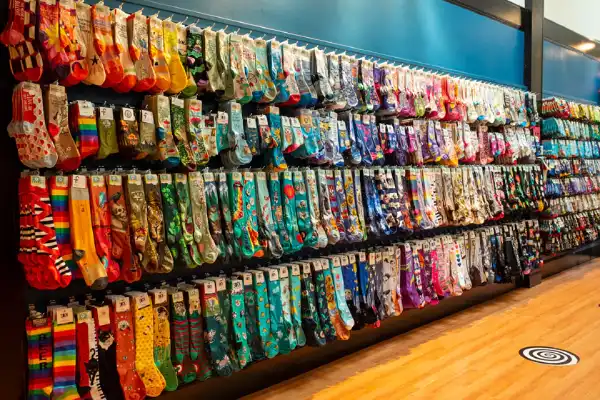
Printed socks have become one of the most versatile and eye-catching products in the custom apparel world. Whether you’re a fashion label launching seasonal collections, a brand building promotional merchandise, or a sports company looking for high-performance designs, printed socks allow you to showcase logos, graphics, and colors in ways that knitted socks cannot.
Unlike knitted patterns, which are limited by yarn colors and stitch density, printed socks apply the design after knitting, offering virtually unlimited freedom of expression. From full-color photo images to bold logos on dark backgrounds, printing technology can transform a plain pair of socks into a powerful branding tool.
👉 Still not sure if your socks are knitted or printed? Check out our in-depth guide on how to tell whether socks are knitted or printed for a quick breakdown.
The Main Printing Methods for Custom Socks
When it comes to producing custom printed socks, three main techniques dominate the market: sublimation printing, digital direct printing (DTG/DTF), and screen printing. Each has unique strengths, limitations, and best-use scenarios. Let’s explore them in detail.
Sublimation Printing / Heat Transfer
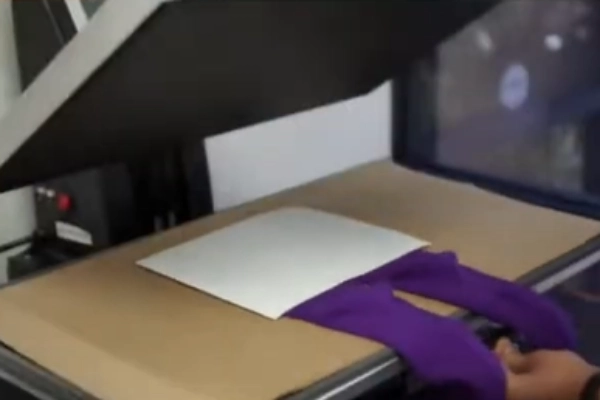
Sublimation printing uses heat and pressure to transfer specially formulated inks from paper onto polyester socks. The design is first printed onto transfer paper using sublimation ink. The sock is then stretched over a jig (a form that keeps it flat and smooth), and the transfer paper is applied to the surface. When heated to around 200°C (400°F), the ink turns into gas and bonds with the polyester fibers, producing a permanent, high-resolution print.
Best Materials
Sublimation is only effective on socks made from polyester or polyester-coated materials. It works best on white or light-colored socks, as sublimation ink is transparent; dark colors will block the design.
Strengths
- Produces all-over, full-color designs that look photographic.
- Zero hand feel: the print is inside the fibers, not on top of them.
- Excellent wash durability—designs won’t crack or peel.
- Great for on-demand production without setup costs.
Limitations
- Works only on polyester, not cotton or wool.
- Limited to white/light socks; cannot print bright colors on dark socks.
- Labor-intensive for huge orders, since each sock must be pressed individually.
Sublimation is considered a relatively clean technology: it uses almost no water and produces minimal chemical waste. However, since it relies on polyester—a petroleum-based fiber—there are concerns about microplastics. Many manufacturers like us, Max Hosiery, now use recycled polyester (rPET) to address this.
Digital Direct Printing (DTG, DTF, and 360° Printing)
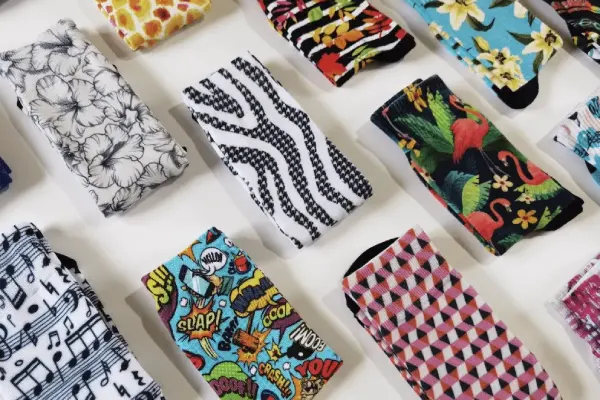
Digital direct printing uses specialized inkjet printers to apply designs directly to the surface of the sock. There are several variations:
- DTG (Direct-to-Garment): prints directly onto the sock with textile pigment inks.
- DTF (Direct-to-Film): prints the design onto a film, which is then heat-pressed onto the sock.
- 360° Digital Printing: rotates the sock around a cylinder while printing, creating seamless all-over designs.👉 Want to see how 360° digital printing works in action? Watch this short video below to see how socks are rotated and printed seamlessly all around.
Best Materials
Digital printing is the most versatile method and works on cotton, polyester, nylon, blends, and even specialty fibers. Pigment inks are often used for cotton, while disperse inks can print directly onto polyester. For dark socks, white ink or DTF is used as a base layer.
Production Process Details
- Design preparation: processed through RIP software to optimize color accuracy.
- Pretreatment (for cotton): a light coating is applied to help the ink bond with fibers.
- Printing: the sock is secured on a flatbed jig or cylindrical roller. The printer applies the design line by line.
- Fixation: printed socks are cured with heat (160–170°C) to lock in the pigments.
- Optional DTF step: the design is printed on PET film with adhesive powder, then heat-pressed onto socks.
Strengths
- Extremely flexible: works on multiple fabrics, including cotton (where sublimation fails).
- Handles complex, multi-color, and photographic designs with ease.
- Perfect for small runs or on-demand production—no need for screens or plates.
- Can achieve 360° all-over prints with modern equipment.
Limitations
- Slower than screen printing for very large orders.
- White ink (needed for dark socks) increases cost and may affect hand feel.
- Requires more equipment maintenance, as inkjet heads are sensitive.
This is the go-to method for brands, small businesses, and e-commerce sellers who need flexibility, variety, and short turnaround times. It’s also excellent for testing new designs, creating limited editions, or offering personalization options. Digital printing is one of the most eco-friendly options in the industry. It uses less water, less energy, and less ink waste compared to traditional methods. Because it enables on-demand production, it also reduces overstock and unsold inventory.
Screen Printing
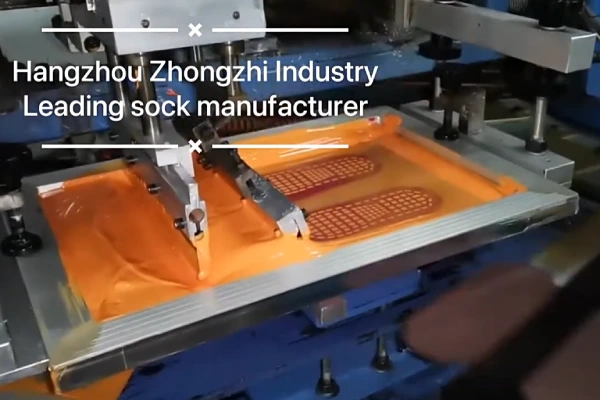
Screen printing is the traditional method of applying ink through a mesh stencil (screen) onto the sock’s surface. Each color in the design requires its own screen, so multi-color designs need multiple passes. After printing, the socks are dried or cured to set the ink.
Best Materials
Screen printing can be used on cotton, polyester, nylon, and blends, as long as the correct type of ink is chosen. Plastisol inks are commonly used for bold colors on dark socks, while water-based inks provide a softer feel on lighter socks.
Strengths
- Produces bold, vibrant colors with strong coverage—even on dark socks.
- Incredibly durable—logos and text stay intact after many washes.
- Cost-effective at scale: once screens are made, thousands of socks can be printed quickly.
- Can use specialty inks (metallic, puff, glow-in-the-dark).
Limitations
- Setup costs are high: each new design/color needs a new screen.
- Inefficient for small or frequently changing orders.
- Limited in producing photo-quality or gradient designs.
Traditional screen printing uses more water and chemicals (emulsions, solvents, and cleaning agents) than digital or sublimation printing. However, improvements such as water-based inks and automated cleaning systems are making it more eco-friendly.
How the Methods Compare
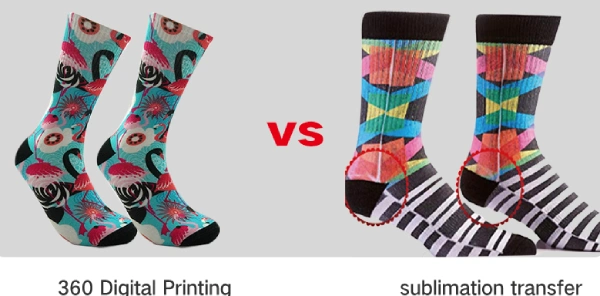
- Sublimation socks: photo-quality, no hand feel, perfect for polyester and vibrant all-over designs.
- Digital printed socks: flexible, works on cotton and blends
- Screen printed socks: bold, durable, especially on dark socks with logos.
| Sublimation Printing | Check if the sock is polyester and the design covers it edge to edge. The inside may show a faint mirror image of the print. | Smooth surface, zero hand feel (ink infused into fibers). | Very high — won’t crack or peel. |
|---|---|---|---|
| Digital Direct Printing (DTG / DTF / 360°) | On cotton or blends, the design sits on the surface. On dark socks you may notice a thin white base layer. | Soft finish on light fabrics; slightly thicker feel with white ink on dark socks. | Good — lasts well if properly cured. |
| Screen Printing | You can feel the ink sitting on top of the fabric. Designs are bold, solid, and a bit raised. | Noticeable ink layer with strong, opaque coverage. | Excellent — thicker ink layer resists wear. |
How to Choose the Right Sock Printing Method
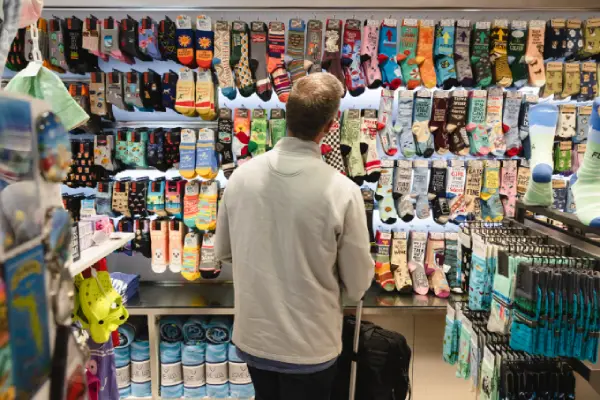
By matching your material, design, and quantity with the right method, you’ll get the best balance of quality, cost, and durability. When deciding which printing method to use, consider three factors:
Sock Material
- Polyester → Sublimation
- Cotton/blends → Digital printing
- Dark socks → Screen printing or digital with white ink
Order Quantity
- Small or custom batches → Sublimation or digital
- Large, repeat orders → Screen printing
Design Style
- Complex artwork/photos → Sublimation or digital
- Simple, bold logos → Screen printing
FAQs
What is the difference between tie-dye socks and printed socks?
Tie-dye socks are colored by dipping the fabric in dyes, which creates unique, irregular patterns. Printed socks use sublimation, digital, or screen printing to apply precise logos, graphics, or images, allowing for consistent designs in bulk.
Printed socks vs knitted socks – what’s the difference?
Knitted socks build patterns with yarn during the knitting process, which limits color variety and detail. Printed socks add graphics afterward, giving you unlimited design flexibility, from photo images to full-color gradients.
Which lasts longer: sublimation, digital, or screen printed socks?
Sublimation and screen printing are the most durable: sublimation bonds dye into polyester fibers, while screen printing lays down a thick ink layer. Digital prints last well with proper curing but may show lighter wear over time.
Are printed socks suitable for fashion brands?
Yes. Printed socks are popular in retail and fashion because they allow vibrant all-over artwork, fast design changes, and seasonal collections, unlike traditional knitting which limits creativity.
Do printed socks feel different from regular socks?
Sublimation socks feel identical to plain polyester socks since the ink fuses into the fabric. Digital prints are soft on light fabrics but slightly thicker with white ink. Screen prints feel raised and more textured to the touch.
Conclusion
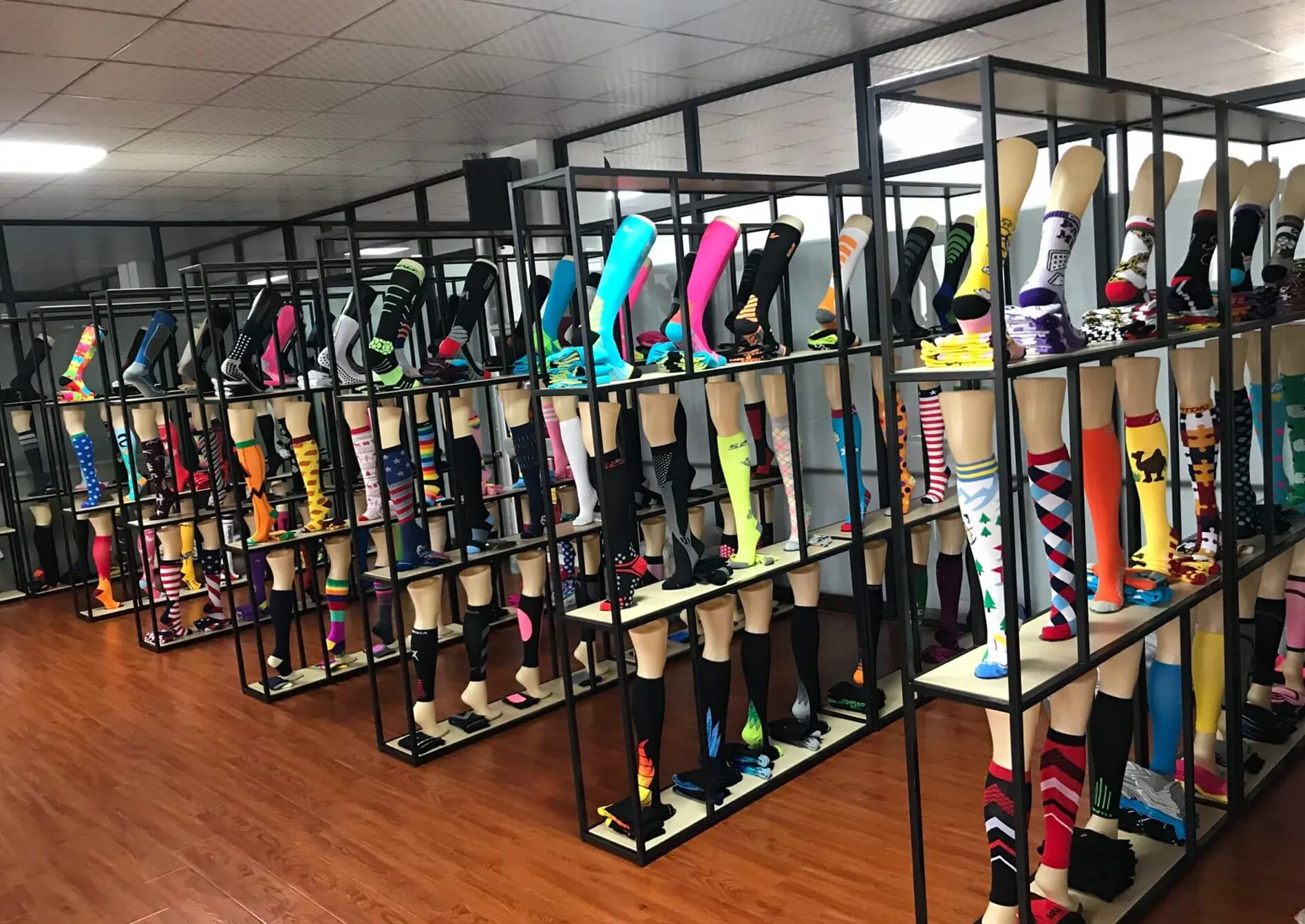
Printed socks open up endless possibilities for design, branding, and customization—whether you choose sublimation, digital printing, or screen printing. By matching the right method with your materials and order needs, you’ll achieve the perfect balance of quality and style.
✨ Ready to bring your sock designs to life? Contact us today to request samples and start your custom socks project.
